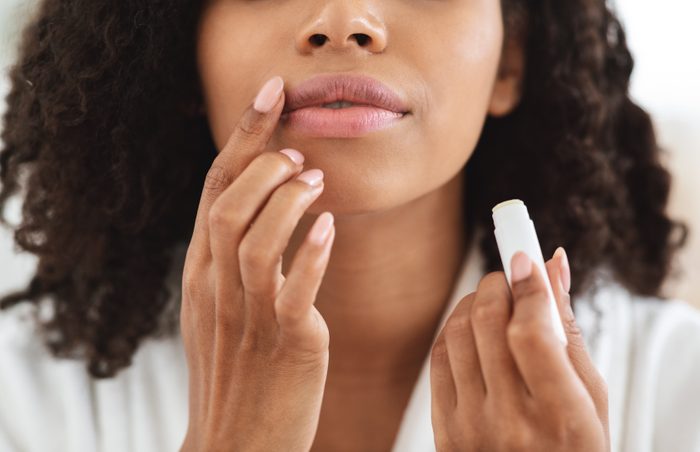You’re Forgetting to Put SPF Here

Protect your pout from sunburns this summer.
By now, most of us are familiar with the importance of wearing sunscreen to protect against the sun’s harsh UV rays, which can cause skin damage and lead to cancer. As a reminder, for the best protection, sunscreen needs to be water-resistant, broad-spectrum and has an SPF of at least 30. And, of course, don’t forget to reapply every two hours. But, even if you diligently apply (and reapply) sunscreen to your face and body, you might be missing one of the most important spots to protect: your lips.
To learn more about applying SPF to your lips and sunburned lips, we spoke to board-certified dermatologist Dr. Susan Poelman, the co-director of Beacon Dermatology in Calgary, about why it’s important to wear SPF on your lips and what to do if you get sunburned lips.
(Related: The Best Lip Balms with SPF)
Can lips get sunburned?
Yes, you can get sunburned lips. Sunburned lips are just like a sunburn anywhere else on your body, says Poelman. The lips become chapped and can blister, they may peel and the area will be super red afterwards. “Sunburn essentially represents UV damage to the skin and the accumulation of those free oxygen radicals that can lead to skin cancer,” says Poelman. Aside from causing skin cancer, sunburns can also cause freckling, dyspigmentation, wrinkling and dry out your lips.
Wait, you can get skin cancer on your lips? What does that skin cancer look like?
You can most definitely get skin cancer on your lips. “The most significant risk from sunburned lips is of developing skin cancer,” says Poelman. Squamous cell carcinoma, a form of skin cancer, is most commonly found on lips and looks like a hard, white bump that can be tender.
One warning sign that should send you straight to your derm’s office is if you develop something called actinic keratosis (which is also sometimes called solar keratosis), which is like a pre-skin cancer. “It’s step one before squamous cell carcinoma,” says Poelman. Actinic keratosis looks like a whiteish scale on your lips that doesn’t go away with lip balm or prescription ointments.
Melanoma is the deadliest type of skin cancer. Though it’s rarer to get melanoma on your lips, it’s still possible especially if you forgo SPF to your lips. Typically, melanoma presents itself as a brownish, irregularly sized freckle and you should get it checked out by a medical professional once you notice it.
(Related: 6 Dermatologist-Approved Face Sunscreens to Wear Every Day)
Can sunburned lips turn into cold sores?
While a sunburn doesn’t necessarily turn into cold sores, cold sores can be triggered by getting a sunburn. “Anytime you have a compromised skin barrier and you introduce a virus, the virus can take hold more easily,” Poelman says. Basically, when your skin is damaged, the immune system that’s normally protecting against cold sore-causing viruses isn’t as active, making you more vulnerable to pesky (and often painful) spots.
How do you apply SPF to your lips?
You can apply your normal sunscreen right across your mouth, though there are some products out there that are specially formulated for your lips. Roll-on sunscreen sticks are an easy way to apply and reapply SPF on your lips— you can use it just like you would use lip balm. Like with coverage for the rest of your body, sunscreen for your lips should also have an SPF of at least 30 and you should be reapplying every two hours or more frequently if you’re sweating or swimming.
Lip balms with SPF are another easy way to protect your lips from the sun. According to Poelman, it’s important to make sure that your lip balm has a high enough SPF (SPF 30 or higher!) and to avoid fragranced products which can lead to irritation and promote sunburns.
(Related: 5 of Best Tinted Sunscreens, According to Dermatologists)
What’s the best treatment and home remedy for sunburned lips?
If you come home from a beach day with sunburned lips, Poelman recommends using a vitamin C serum “because it can take away those sunburned cells.”
Zinc oxide diaper cream is another one of Poelman’s sunburn relief hacks. “Zinc has wound healing properties and it’s soothing and creates a good barrier,” she says. If you’ve got an aloe vera plant kicking around at home, slicing up one of its leaves and applying the gel to the burned area can bring relief, as can cold compresses.
For really bad sunburns, Poelman recommends getting in touch with your dermatologist.
Next, protect your skin from the sun’s harsh rays with these hats.




